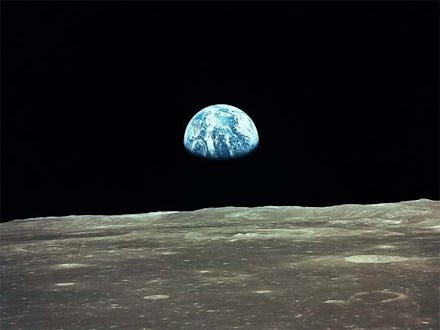This Picture from 45 Years Ago Today Is Pretty Amazing

Kind of a sobering picture, isn't it?
On July 20, 1969, at 4:18 p.m ET, Americans Neil Armstrong and Buzz Aldrin on Apollo 11 landed their lunar module on what Aldrin described as the "magnificent desolation" of the lunar surface
Armstrong radioed: "Houston, Tranquility Base here. The Eagle has landed." Back in Texas, the NASA mission control celebrated.
There was a live, world-wide TV broadcast of the event. Armstrong stepped onto the lunar surface and described the event as "one small step for [a] man, one giant leap for mankind."
(Fox has a great recap of the moment)
This was Neil Armstrong immediately after his, and mankind's, very first moon walk.
Image credit: NASA
The astronauts left behind an American flag, a patch honoring the fallen Apollo 1 crew who died in a cabin fire during a launch rehearsal test, and a plaque that had been hanging on one of Eagle's legs. The plaque reads, "Here men from the planet Earth first set foot upon the moon. July 1969 A.D. We came in peace for all mankind."
The crew returned to Earth on July 24.
Apollo 11 wasn't just a technological and scientific victory — it was also a political one. The moon landing effectively ended the Cold War Space Race between the U.S. and USSR. It also achieved a national goal set by the late President John F. Kennedy in a 1961 speech before Congress, "before this decade is out, of landing a man on the Moon and returning him safely to the Earth."
Today, things are a bit different. There is no lofty goal set by a pioneering U.S. leader to reach further into space. NASA is being scaled back. As National Geographic reports, since the end of the Apollo missions in 1973, the space agency's budget has steadily declined from 1.35% of federal spending to less than 0.6%. Cuts threaten spacecraft, telescopes and research, and NASA struggles to clarify its mission in the post-space shuttle era. National Geographic adds that one vision of future space exploration is the return of humans to the moon by 2020, in preparation for visits to Mars and possibly beyond.
By Chris Miles July 30, 2014
By now, most people who pay attention to pop culture have heard of the video of Orlando Bloom attacking Justin Bieber outside an Ibiza restaurant. It's been played over the news ad naseum, generating hundreds of articles and blog posts (even from the most respected news outlets), discussing everything from the long list of people who hate Justin Bieber to what the woman at the center of it all did during the fight.
But as this video went viral, it likely crowded your Facebook and Twitter newsfeed, pushing out a more truly important story.
This is the UN's Chris Gunness. He breaks down in tears while in an interview on Al Jazeera.
Gunness, a spokesman for the United Nations Relief and Works Agency (UNRWA), was discussing an Israeli air strike that killed up to 20 Palestinians at a UN school. Gaza residents were told to seek safety at the school after days of heavy bombing. An Israeli tank shelling completely demolished the building.
His emotion sums up the Israel-Palestine crisis — one that is getting worse daily.
The death toll in Gaza is now over 1,200, and the United Nations estimates that 70-80% of the dead are civilians. A time lapse video appears to show an entire Gaza neighborhood totally annihilated after an hour of sustained air strikes.
While Orlando Bloom and Justin Bieber were battling it out, this was happening — this is what real news looks like:
Bombs also fell near areas where international journalists were housed.
Editor's Note: This story has been updated to remove language that was used without attribution to NASA, National Geographic, and Wikipedia. We apologize to our readers for this violation of our basic editorial standards. Mic has put in place new mechanisms, including plagiarism detection software, to ensure that this does not happen in the future.